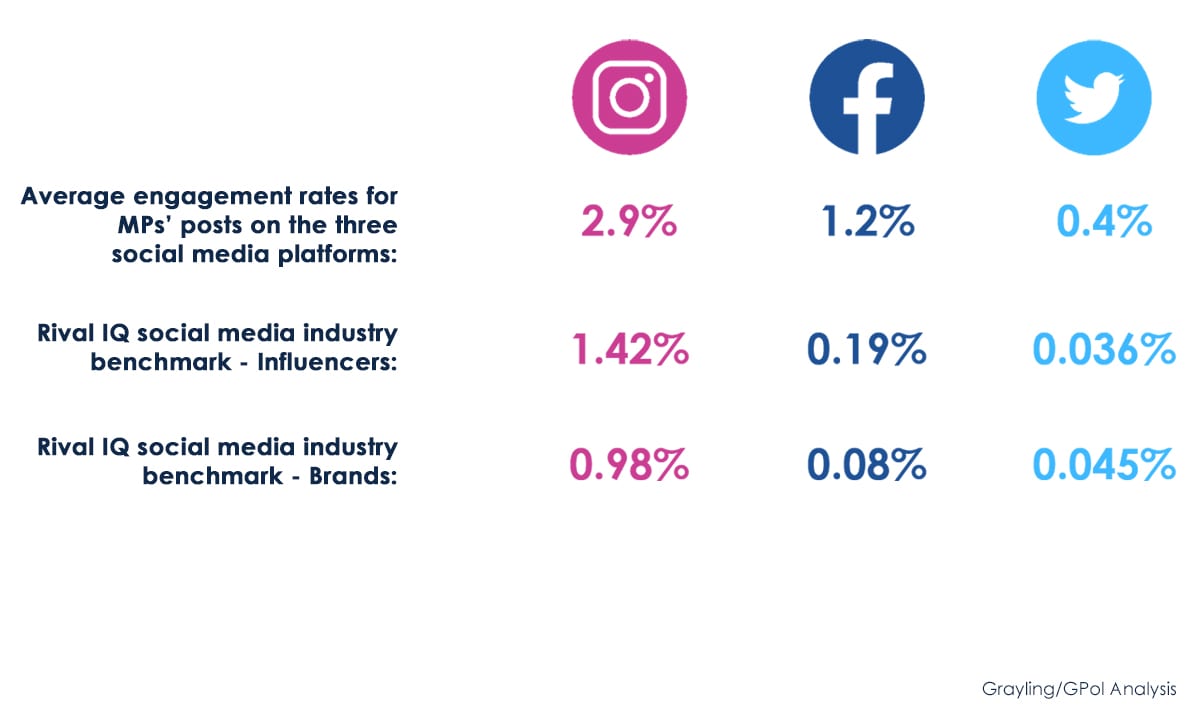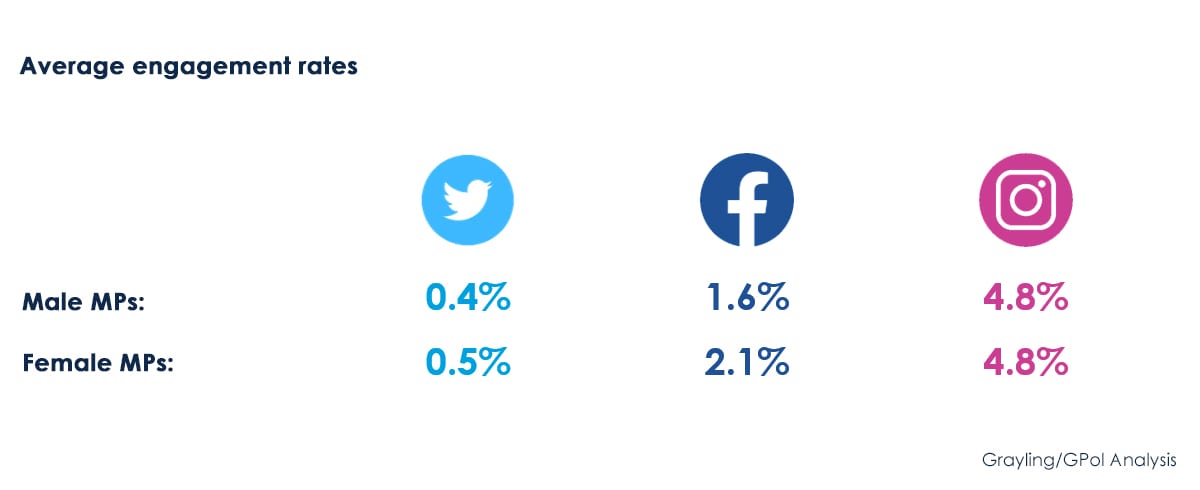First pan-European study published on the way politicians are using social media
| By Ayer Mehmet | 0 Comments

Grayling has published the first pan-European study on the way in which politicians across Europe are using social media, revealing the impact of geography, gender, age and political alignment on social media communications.
The study, which was conducted in partnership with social media intelligence firm Linkfluence, analysed almost 3 million pieces of content posted by members of Parliament across 17 European countries, as well as the European Parliament, on Twitter, Facebook and Instagram.
The role of social media as a channel for engaging policy-makers has been on the agenda for Public Affairs professionals for a long time – certainly since the power of social media in political campaigning became clear, which has been obvious at least since Barack Obama’s first presidential campaign in 2008.
But how are politicians in Europe actually using social media?
The volume of activity varies quite significantly in different parts of Europe:

“The results are, to say the least, fascinating but it’s not easy to pick out clear explanations for the geographical discrepancies we see in how much MPs/MEPs are posting on social media. It’s much easier to refute theories than to suggest explanations which fit the data. There are no doubt multiple factors, and that’s ok with us. We love data but, like all good Public Affairs professionals, we like speculation and a good debate even more”, said Russell Patten, CEO of Grayling Brussels & Grayling’s Chairman of European Public Affairs.
MPs are not focusing on the same platforms as their constituents
In all bar one of the 17 countries, Facebook ranks as the most popular of the three platforms amongst the general public, with Instagram second and Twitter third (Russia is the only exception; there, Instagram ranks first, followed by Facebook and then Twitter).
However, MPs are publishing 67% of their posts on Twitter, with 28% on Facebook and 5% on Instagram. And the data for followers are similar: Twitter accounts for 79%, Facebook for 14% and Instagram for 7%.

“The fact that Twitter is the most popular social media platform probably won’t surprise many people. However, the results also highlight the diversity that exists across Europe, as there are some very local exceptions to regional trends, even between neighbouring countries. For example, given that the Czech Republic and Slovakia were one country for many decades before 1993, you would expect Czech and Slovak MPs to behave in a very similar manner on social media. But the opposite is true. Twitter dominates in the Czech Republic; in Slovakia, on the other hand, more than 80% of posts are on Facebook – with Twitter playing a negligible role. There are many factors that might explain this, but without understanding these local dynamics, it is impossible for businesses to run effective multi-country digital advocacy campaigns”, said Jakub Hudec, Head of Public Affairs, Grayling Czech Republic.
MPs are genuine influencers online
The ‘engagement rate’ is simply the number of engagements (likes, shares, retweets, comments etc.) with a piece of content divided by the number of people who follow that account:

“Looking at the average engagement rate for Members of Parliament across Europe, they engage their audiences via Instagram, Facebook and Twitter much more effectively than the average social media industry benchmarks for brands, and even ‘influencers’. There could be several reasons for this. First, while Twitter, Facebook or Instagram users may choose to follow lifestyle accounts in a more ‘passive’ capacity, the action of following a politician will usually translate into ‘active’ political engagement and followers voicing their opinions on the posts. Second, politicians rapidly understood that social media platforms constitute a unique opportunity to transform the way they communicate to citizens. This means moving away from broadcasting to stimulating an actual debate which allows politicians to ‘survey’ their voters’ positions in real time, ahead of electoral milestones”, said Delphine Millot, Managing Director, Grayling Brussels.
Male and female MPs are using social media differently
Male MPs are posting slightly more on Facebook than their female counterparts, while women are posting more than men on Twitter (and Instagram). Average engagement rates for female MPs are also higher than for male MPs – at least on Facebook and Twitter:
 “The fact that female MPs favour Twitter even more than men is a surprise given that Twitter is the most male-dominated of the three platforms amongst the general public. There’s also, let’s face it, the abuse that politicians receive on social media, particularly on Twitter – and which afflicts female MPs even more seriously than it does men. It is partly explained by the fact that female MPs are, on average, younger (our analysis shows that younger MPs favour Twitter and Instagram) and are also more likely to be on the Left (particularly the Centre Left, where Twitter is clearly the favoured platform). And why are female MPs seeing higher engagement rates for their posts on both Twitter and Facebook? Based on a couple of micro analyses, posts which generate the strongest engagement are those which find the right tone for the moment, are constructive and avoid trying to score cheap political points. Maybe this is where female politicians have an edge over some of their male counterparts?”, said Geraldine Schroeder, Managing Director, Grayling Germany.
“The fact that female MPs favour Twitter even more than men is a surprise given that Twitter is the most male-dominated of the three platforms amongst the general public. There’s also, let’s face it, the abuse that politicians receive on social media, particularly on Twitter – and which afflicts female MPs even more seriously than it does men. It is partly explained by the fact that female MPs are, on average, younger (our analysis shows that younger MPs favour Twitter and Instagram) and are also more likely to be on the Left (particularly the Centre Left, where Twitter is clearly the favoured platform). And why are female MPs seeing higher engagement rates for their posts on both Twitter and Facebook? Based on a couple of micro analyses, posts which generate the strongest engagement are those which find the right tone for the moment, are constructive and avoid trying to score cheap political points. Maybe this is where female politicians have an edge over some of their male counterparts?”, said Geraldine Schroeder, Managing Director, Grayling Germany.
Age is also a factor

“The fact that age affects social media use isn’t exactly a bombshell – most of us know that from our own families. What is surprising is that the very youngest MPs (the under 35s, who account for approximately 10% of the total) are not the most active group on social media. They are, though, the most active on Instagram and their content generates the highest engagement rates across all three platforms. This suggests that it’s quality rather than quantity for the youngest MPs: they understand how to use social media and prioritise generating comments, likes, shares and retweets over a high volume of posts”, said Ben Petter, Chief Operating Officer, Europe at Grayling.
The extreme ends of the political spectrum are disproportionately active

“This data shows that the Right have been the most effective at building a following on social media. The Right’s messaging is also spread more evenly across all three platforms, suggesting they are the most efficient in sharing content and certainly the most consistent in using them. The Right also has the highest level of engagement on Twitter – although this includes opponents engaging to criticise. All in all, the Right are winning on social media at the moment, by a very wide margin on Twitter and Instagram. This has also provided them with a platform to get noticed by traditional media in a way that hasn’t been available to similar parties in the past. It remains to be seen if this is a long-lasting structural benefit for the Right, as a result of social media making it difficult to convey political context, complexity and nuance or whether a combination of platforms moderating content more and other groups improving their messaging on social media mean this trend will change in the future”, said Clare Moody, former MEP and Senior Strategic Director at Grayling.
Interested in a bespoke analysis focused on priority topics for your company?
Grayling, in partnership with Linkfluence, has launched ‘GPol’, a social media monitoring and digital advocacy service. GPol combines the social listening capabilities of Linkfluence with the local market knowledge of Grayling’s unrivalled network of Public Affairs consultants across Europe. Find out more about how GPol will help you turn those insights into effective advocacy campaigns here.
For more details on our European research, or to explore the data for a specific country, please contact Ben Petter: Ben.Petter@grayling.com or send an email to GPol@grayling.com.